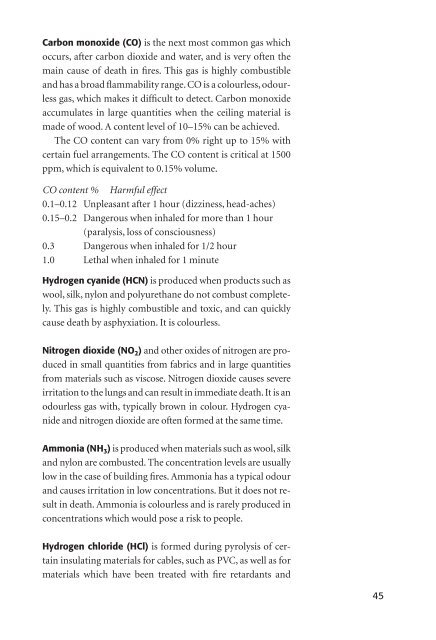You also want an ePaper? Increase the reach of your titles
YUMPU automatically turns print PDFs into web optimized ePapers that Google loves.
Carbon monoxide (CO) is the next most common gas which<br />
occurs, after carbon dioxide and water, and is very often the<br />
main cause of death in fi res. This gas is highly combustible<br />
and has a broad fl ammability range. CO is a colourless, odourless<br />
gas, which makes it diffi cult to detect. Carbon monoxide<br />
accumulates in large quantities when the ceiling material is<br />
made of wood. A content level of 10–15% can be achieved.<br />
The CO content can vary from 0% right up to 15% with<br />
certain fuel arrangements. The CO content is critical at 1500<br />
ppm, which is equivalent to 0.15% volume.<br />
CO content % Harmful effect<br />
0.1–0.12 Unpleasant after 1 hour (dizziness, head-aches)<br />
0.15–0.2 Dangerous when inhaled for more than 1 hour<br />
(paralysis, loss of consciousness)<br />
0.3 Dangerous when inhaled for 1/2 hour<br />
1.0 Lethal when inhaled for 1 minute<br />
Hydrogen cyanide (HCN) is produced when products such as<br />
wool, silk, nylon and polyurethane do not combust completely.<br />
This gas is highly combustible and toxic, and can quickly<br />
cause death by asphyxiation. It is colourless.<br />
Nitrogen dioxide (NO 2) and other oxides of nitrogen are produced<br />
in small quantities from fabrics and in large quantities<br />
from materials such as viscose. Nitrogen dioxide causes severe<br />
irritation to the lungs and can result in immediate death. It is an<br />
odourless gas with, typically brown in colour. Hydrogen cyanide<br />
and nitrogen dioxide are often formed at the same time.<br />
Ammonia (NH 3) is produced when materials such as wool, silk<br />
and nylon are combusted. The concentration levels are usually<br />
low in the case of building fi res. Ammonia has a typical odour<br />
and causes irritation in low concentrations. But it does not result<br />
in death. Ammonia is colourless and is rarely produced in<br />
concentrations which would pose a risk to people.<br />
Hydrogen chloride (HCl) is formed during pyrolysis of certain<br />
insulating materials for cables, such as PVC, as well as for<br />
materials which have been treated with fi re retardants and<br />
45

















